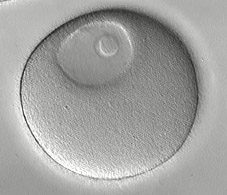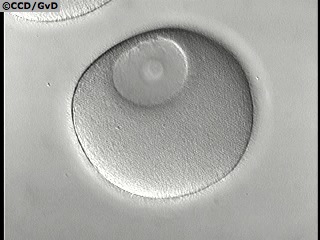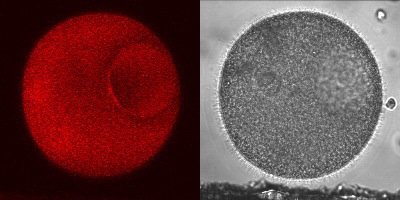A Pycnopodia oocyte.
Image courtesy of George von Dassow, Center for Cell
Dynamics, Univ. of Washington.

During oogenesis dramatic changes take
place within the oocyte as it enters meiosis. Because
sea urchin eggs complete meiosis before being shed,
they are less convenient for studying meiotic
maturation. Starfish oocytes, on the other hand,
complete meiosis only upon suitable hormonal
stimulation, and so they are very useful for studying
the cellular and molecular mechanisms of meiotic
maturation. One key event in meiotic maturation is
germinal vesicle breakdown (GVBD), which marks
the onset of meiosis I. The movies on this page show
GVBD in starfish oocytes. The first is a Nomarski
movie of GVBD in a
Pycnopodia oocyte (courtesy
George von Dassow,
Center for Cell Dynamics, Univ. of
Washington). The second visualizes GVBD in the bat
star,
Asterina miniata, using a fluorescent
dextran. When the nuclear envelope breaks down, the
dextran can enter the nucleus (courtesy
Mark Terasaki, Univ. of Connecticut
and
Jan Ellenberg, EMBL, Heidelberg).
 |
 |
|
GVBD in a
Pyncnopodia oocyte (5.4 Mb)
|
GVBD in
Asterina visualized using dextran (1.3
Mb)
|
 During oogenesis dramatic changes take
place within the oocyte as it enters meiosis. Because
sea urchin eggs complete meiosis before being shed,
they are less convenient for studying meiotic
maturation. Starfish oocytes, on the other hand,
complete meiosis only upon suitable hormonal
stimulation, and so they are very useful for studying
the cellular and molecular mechanisms of meiotic
maturation. One key event in meiotic maturation is
germinal vesicle breakdown (GVBD), which marks
the onset of meiosis I. The movies on this page show
GVBD in starfish oocytes. The first is a Nomarski
movie of GVBD in a Pycnopodia oocyte (courtesy
George von Dassow, Center for Cell Dynamics, Univ. of
Washington). The second visualizes GVBD in the bat
star, Asterina miniata, using a fluorescent
dextran. When the nuclear envelope breaks down, the
dextran can enter the nucleus (courtesy Mark Terasaki, Univ. of Connecticut
and Jan Ellenberg, EMBL, Heidelberg).
During oogenesis dramatic changes take
place within the oocyte as it enters meiosis. Because
sea urchin eggs complete meiosis before being shed,
they are less convenient for studying meiotic
maturation. Starfish oocytes, on the other hand,
complete meiosis only upon suitable hormonal
stimulation, and so they are very useful for studying
the cellular and molecular mechanisms of meiotic
maturation. One key event in meiotic maturation is
germinal vesicle breakdown (GVBD), which marks
the onset of meiosis I. The movies on this page show
GVBD in starfish oocytes. The first is a Nomarski
movie of GVBD in a Pycnopodia oocyte (courtesy
George von Dassow, Center for Cell Dynamics, Univ. of
Washington). The second visualizes GVBD in the bat
star, Asterina miniata, using a fluorescent
dextran. When the nuclear envelope breaks down, the
dextran can enter the nucleus (courtesy Mark Terasaki, Univ. of Connecticut
and Jan Ellenberg, EMBL, Heidelberg).

